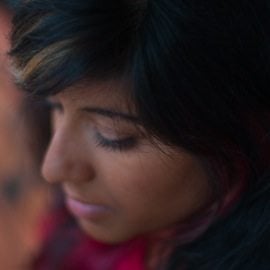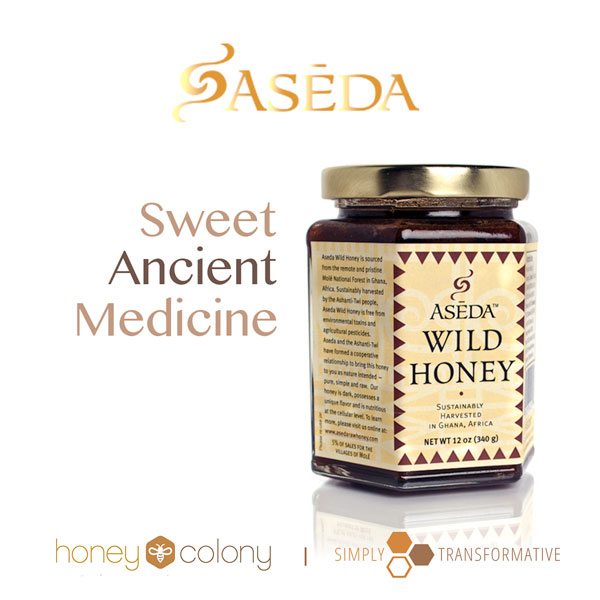Sharing is caring!
The best honey in the world is cultivated in the symbiotic collaboration of bees, the tribe of Aseda, Mole National Forest, and two American visionaries.
By it’s very nature, a forest is a symbiotic eco-sphere. Plants, animals, and soil engage with each other on a second by second basis, working together so that each can produce a fraction of what it takes for the forest to come alive and thrive. Their efforts denote the beauty of a complete, independent system. A forest doesn’t need outside forces to thrive.
The Mole National Forest is no exception to this rule. Unspoiled by modern industry, it is situated in the Northern Region of Ghana, a good 12-15 hours drive from the nearest town by dirt roads and river-crossings. Its inaccessibility makes it an unlikely tourist destination, maintaining its pristine wilderness. Aseda founder Anthony Baron Kirk describes it as “an ancient, primal force that is completely untouched.” Traveling there for the first time was a journey of discovery in which he felt an innate sense of purpose.
Anthony first tasted his life’s purpose at a friend’s house in Salt Lake City, Utah. The dark, primal substance sat in a questionable-looking bucket. Wild Raw Honey—harvested by tribal communities from the Mole forest. At first glance, he knew he was peering into something completely special – perhaps the best honey he may have ever tasted.
“I tasted the honey and the spirit of the honey spoke to me. From that first taste, I had a whole vision of what I wanted to do with this company.”
The experience was so powerful that Anthony feels it changed the very fabric of his character.
A focused and passionate individual, Anthony exudes the confidence of a well-seasoned traveler. During one of his many trips to the Mole forest, Anthony found himself engulfed in a swarm of wild, angry Ghanian bees. Protected by his bee-keeping gear, he experienced a transcendent moment. Full moon above, encased in this symphony of buzzing bees, Anthony felt he was receiving a calling, an asking. And he was.
Bee Vibrations
Vice-President of Aseda, Bessie McIntosh also had a bee calling. It happened when she was eight years old, from a dream in the middle of the night. She was running, running. Over a hill to discover hidden treasure. And what was there? Beehives. Hundreds of beehives. She was reminded of this dream years later when Anthony Baron Kirk approached her to partner with him on his Aseda journey. Bessie recalls this moment of recognition with a burst of youthful exuberance.
She is vibrant, almost ecstatic as she describes her first taste of Aseda honey. “A vibration started at my seat and rose up through my body. It kinda just went into my head and into my toes and it shot straight out of my body. Essentially the spoon of honey raised my vibration,” she says.
The energy was tangible. It motivated her to bring the best honey she had ever known out into the world.
And so Anthony and Bessie created their own version of symbiosis, working in tandem with the Dagomba and Gonjes tribes who reside in the Mole National Forest to harvest and bottle this incredible superfood. This is how Aseda Raw Wild Honey was born. Anthony’s first meeting at the head village took place under the shade of a shea tree; he discussed the future of Aseda while surrounded by a circle of tribe members. It was a clear indication of how the whole community would be involved in the process.
“There is a really beautiful way in which Ghanians live. The people in Mole are an isolated community and they want to remain that way. Their sustainability comes from an innate connection to the earth, to the land. A genuine happiness exists within them.”
It Takes A Village
Nana Kwasi Agyemang, the Ashanti-Twi tribal chief, exudes such happiness as he tells me about the honey. For years, his tribe has been using the honey to heal burns and cure sore throats. Nana refers to himself as a “simple farmer” though it is obvious that this father of three is anything but. An entrepreneur and a community leader, Nana’s connection with the Mole National Forest is palpable. As a tribal chief, Nana feels a responsibility for the region and it’s people. He has been working with them for almost 15 years.
“I work hard not to be an intruder in the forest. I want to help the natives do whatever they can to uplift themselves.”
He is also the eyes and ears of the whole Aseda operation, connecting the dots between Anthony, Bessie, and the tribal peoples who harvest the rich, sweet honey which owes its unique taste to endemic plants such as cacao, shea, and calabash.
“Aseda is helping me to be near the natives. To feel a sense of responsibility to them. With Aseda, we are letting the villagers feel a sense of ownership. If one goes to a village and you want to impose your will on them, it won’t work. We have formed an Aseda Beekeepers Association–the villagers have meetings and deal with problems on their own.”
The community of Aseda is a net cast far and wide. Together with Anthony, Bessie, and Nana, the villagers and tribe members work to create a synchronous relationship that not only contributes to a global community initiative but also produces some of the best honey on earth..
Upon first tasting Aseda honey, your senses are heightened. It is a wild, untamable taste. The flavor is smoky and rich with a delicately sweet aftertaste that makes you lick your lips in search for more. This is the taste of Ghanian bees harvesting honey from an untouched, ancient resource. But it is also the taste of a synergetic community; a conscious, collective effort to create sustainable practices.
Recently, Aseda took this effort one step further and started shipping their honey out of Ghana by boat instead of airplane to cut back on their carbon footprint. The choice is an unwavering demonstration of Aseda’s commitment to the planet.
Seven years ago, Anthony Baron Kirk stepped into unchartered territory and mapped out the path to a reciprocal agreement between himself and the honey harvesters of Northern Ghana. As Nana Kwasi Agyemang humbly states “Getting to know the people is a great achievement. At times, we sleep and eat with them. We do whatever we have to do for them to feel that we are all connected.”
Nana’s words delineate the initiative behind this amazing product. Aseda is not just a honey, it is a connecting force.
 Maya Bastian is a writer, a filmmaker, and an artist. Her wandering soul has taken her on many adventures and there are surely many more to come. Check her out online at www.mayabastian.com or follow her on Twitter and Instagram @mayabasti
Maya Bastian is a writer, a filmmaker, and an artist. Her wandering soul has taken her on many adventures and there are surely many more to come. Check her out online at www.mayabastian.com or follow her on Twitter and Instagram @mayabasti
Submit your story or essay to Buzzworthy Blogs.
- Tags: africa, aseda, ghana, Healthy Sugars, honeybees, organic honey, wild honey


